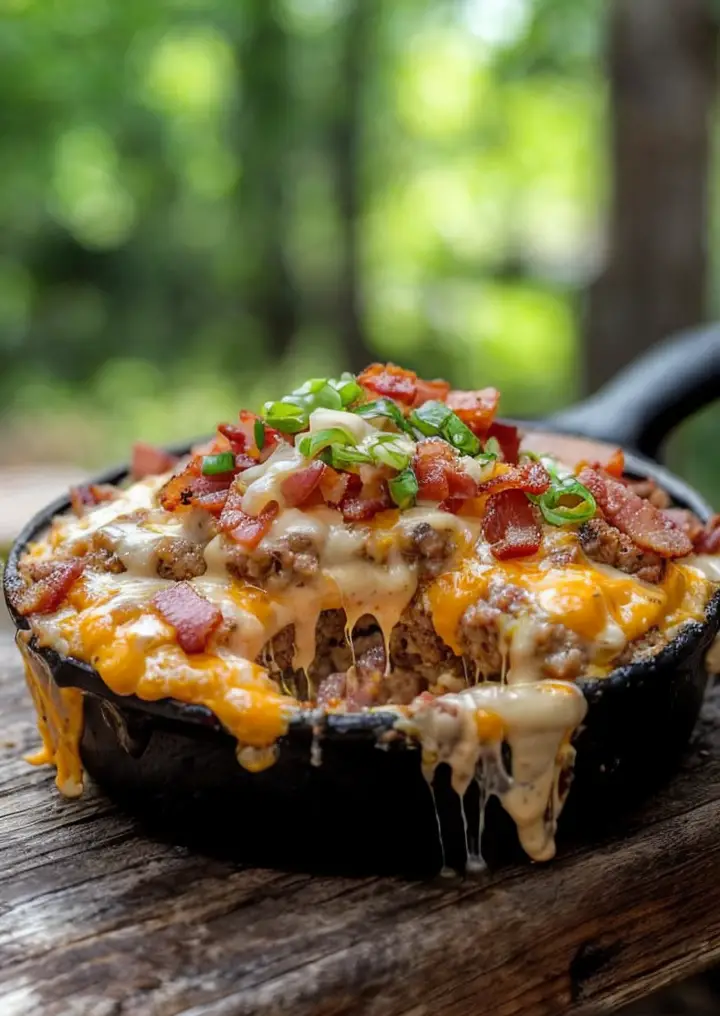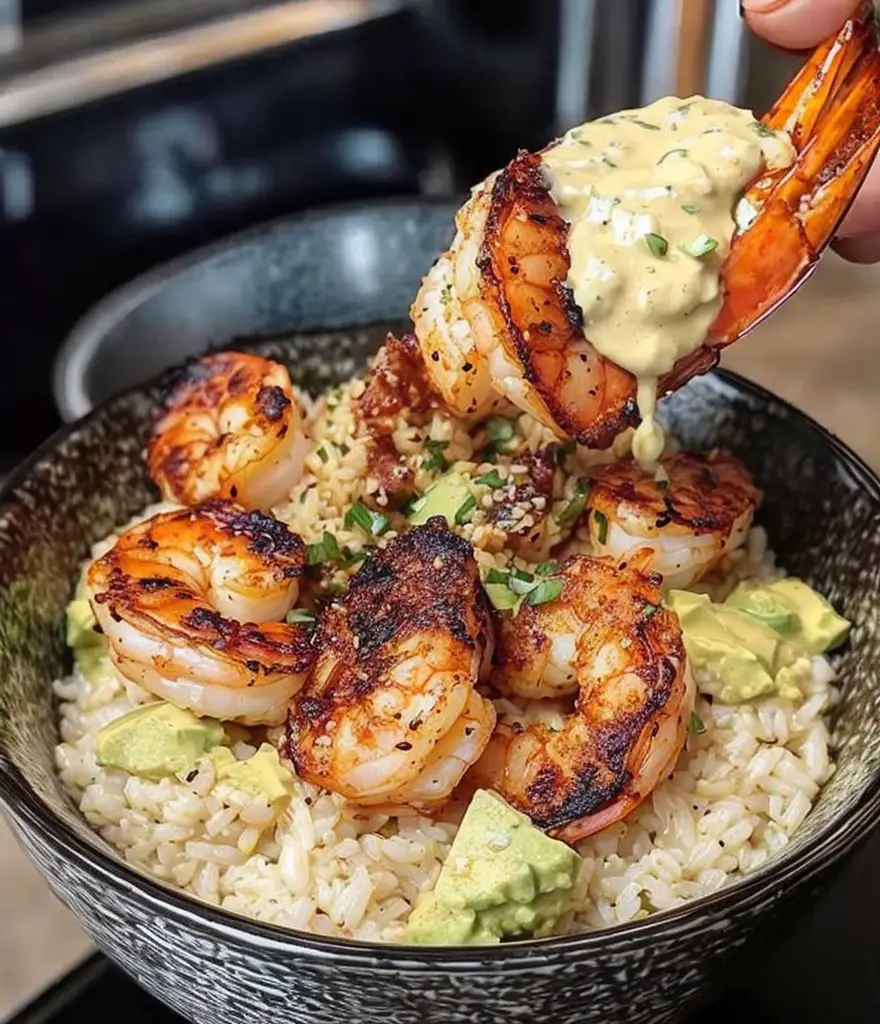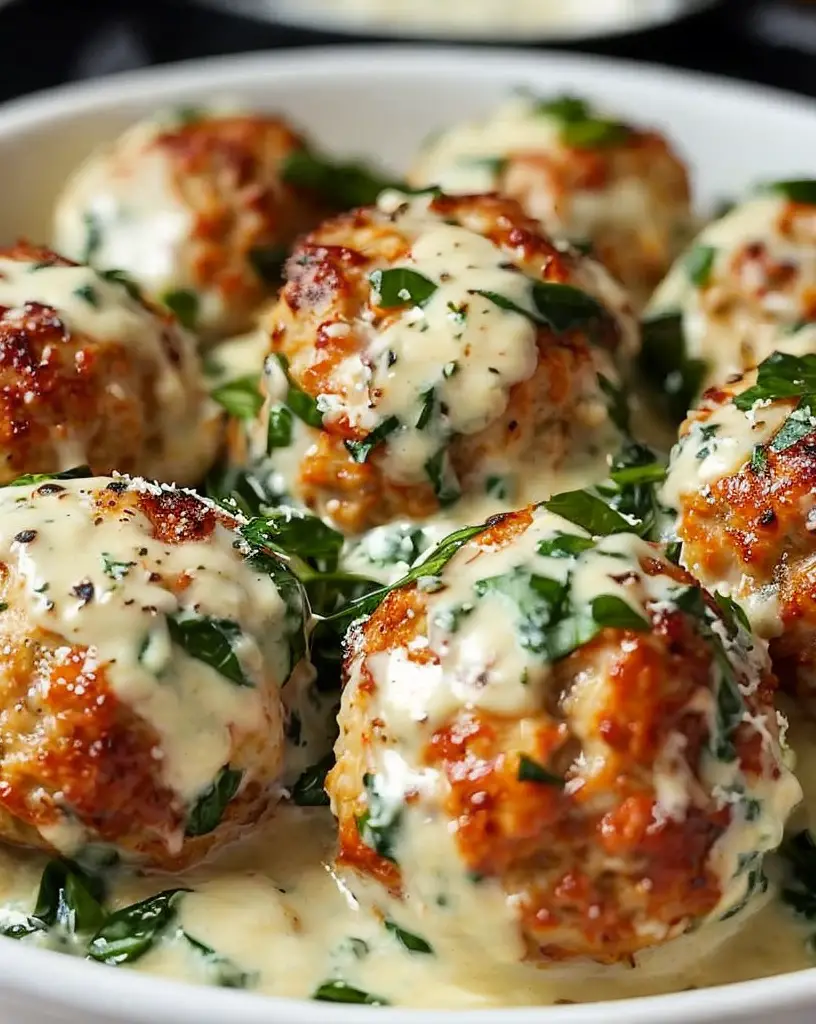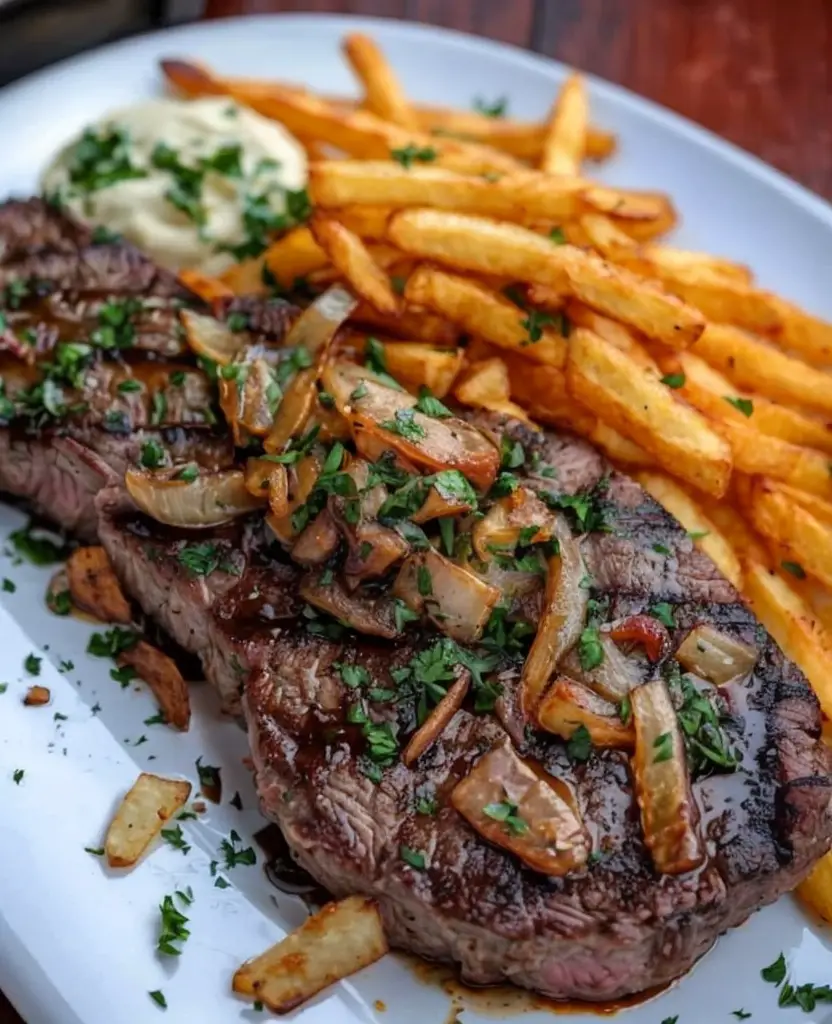Sizzling Bacon Cheeseburger Queso Dip: The Ultimate Flavor Bomb
Discover the joy of indulgence with our Sizzling Bacon Cheeseburger Queso Dip—a dish that marries the hearty richness of a classic cheeseburger with the creamy, gooey goodness of queso dip. This delightful dip is perfect for gatherings, game days, or cozy nights in, ensuring that every bite is packed with flavor. Picture layers of melted cheese, crisp, sizzling bacon, and seasoned ground beef coming together to create an irresistible appetizer that will have everyone at the table coming back for more.
The combination of textures is truly what makes this recipe stand out. The creaminess of the cheese melds beautifully with the crunch of perfectly cooked bacon, while the seasoned beef adds a savory depth that elevates this simple dip into a showstopper. A sprinkle of vibrant green onions or a dollop of sour cream on top not only enhances the presentation but also adds a fresh contrast to the richness below.
Quick Recipe Highlights
- Flavor Profile: The rich, creamy queso combined with the savory bacon and seasoned beef creates an explosion of flavors that satisfies every craving.
- Texture: Expect a delightful blend of creamy, crunchy, and tender textures—melted cheese, crispy bacon, and finely ground beef come together perfectly.
- Aroma: Aromatic notes of sizzling bacon and melted cheese fill the air, inviting everyone to dig in and enjoy.
- Visual Appeal: The golden cheese, crispy bacon bits, and vibrant green onions not only taste amazing but also look irresistible.
- Skill Level Needed: This recipe is easy enough for even novice cooks to master, making it perfect for everyone.
- Special Equipment: A large skillet or slow cooker is essential for achieving the ideal blend of flavors and textures.
Recipe Overview
- Difficulty Level: This dish is classified as easy, which means you don’t need extensive cooking experience. Basic skills like sautéing and mixing are all that’s required.
- Category: This recipe fits perfectly in the appetizer category, making it an ideal choice for parties and gatherings.
- Cuisine: While this dip draws inspiration from classic American cuisine, it’s a fun fusion that embodies comfort food at its finest.
- Cost: Expect to spend around $20 for a full batch, making it budget-friendly for larger gatherings.
- Season: Enjoy this dip anytime, but it truly shines during football season or summer barbecues.
- Occasion: Perfect for casual get-togethers, birthday parties, or even as a game night appetizer.
Why You’ll Love This Recipe
This Sizzling Bacon Cheeseburger Queso Dip delivers on both taste and texture. The delightful combination of gooey cheese and crispy bacon tantalizes your taste buds, while the seasoned ground beef adds just the right touch of umami. The richness of the cheese creates a luxurious mouthfeel that will keep you reaching for more.
Its convenience cannot be overstated. With minimal prep time and a straightforward cooking process, you’ll have a crowd-pleaser ready in about 30 minutes. This dip can be made in a large quantity, making it perfect for feeding a group without endless cooking. Just set it out with tortilla chips or crackers and let your guests dive in.
Nutritionally, while it leans on the indulgent side, you can always adjust the ingredients to enhance its health quotient. Using leaner ground beef or alternative cheeses can reduce the calorie count while maintaining the flavor integrity.
Socially, this dip is a star attraction. Whether you’re hosting a watch party or a potluck, the Sizzling Bacon Cheeseburger Queso Dip invites people to gather around. It’s an interactive dish that encourages sharing and laughter, bridging the gap between strangers and friends alike.
Cost-effectiveness is another highlight of this recipe. You can create a lavish dip without breaking the bank, making it accessible to everyone. Its ingredients are commonplace and affordable, ensuring you won’t have to hunt for expensive items to impress.
Historical Background and Cultural Significance
The origins of cheeseburger dip can be traced back to America’s love for cheeseburgers and the rise of dip culture in the 1970s. As the popularity of cheese dips surged, home cooks began experimenting with the idea of amalgamating the delightful flavors of a classic cheeseburger into a cheesy dip format.
In American culture, tailgating events and game nights have become synonymous with hearty, shareable foods. The Cheeseburger Queso Dip stands as an iconic dish that captures the camaraderie of these gatherings. It embodies both comfort and convenience desired in party settings.
Over the years, this recipe has evolved with variations appearing in different regions. From adding spicy jalapeños in the South to incorporating unique cheeses in the North, every locale gives this dish a distinct flavor twist, expanding its appeal.
Today, this dip is not just a favorite at parties or game days; it has also found its way into restaurants and bars, symbolizing the fusion of traditional American fare with the innovative spirit of modern cooking.
Ingredient Deep Dive
– **Cream Cheese**: A staple in many creamy dips, cream cheese adds rich texture and depth to the dip. It’s low in carbohydrates and provides a good source of calcium, making it a favorable option for cheeseburger dip recipes. When selecting cream cheese, opt for a full-fat version for the best flavor. Store it in the fridge and seal it tightly to maintain freshness.
– **Ground Beef**: This ingredient is central to replicating the cheeseburger experience. Ground beef is an excellent source of protein and essential nutrients like iron and vitamin B12. Choose lean ground beef for a healthier dish. Store raw beef in the refrigerator for up to two days, and remember to cook it thoroughly.
– **Bacon**: The crispy, smoky flavor of bacon brings savory notes to the dip. Bacon is high in protein but also loaded with fat, so moderation is key. Choose thick-cut bacon for more substantial pieces in your dip. Store cooked bacon in an airtight container in the fridge for several days, or freeze for longer storage.
Common Mistakes to Avoid
- Overcooking the cheese: Melting cheese too long can cause it to become rubbery. Keep heat low and stir frequently.
- Using low-quality cheese: High-quality cheese melts better. Avoid pre-shredded cheese as it contains anti-caking agents.
- Not seasoning enough: Seasoned beef is vital for flavor. Don’t overlook salt and pepper in your recipe.
- Too much liquid: Adding excess liquid can make the dip runny. Focus on the right cheese and a little cream for perfect consistency.
- Cooling too much: Ensure the dip remains warm while serving to keep it gooey and delicious.
- Forgetting garnishes: A sprinkle of green onions or jalapeños can elevate the dish both in flavor and presentation.
- Using old ingredients: Always check the expiration dates on dairy products to ensure freshness for optimal taste.
- Not letting it rest: Allowing the dip to sit for a few minutes after cooking enhances the flavor melding.
- Serving without accompaniments: Although delicious by itself, serve with crackers or tortilla chips for the best experience.
- Skipping the toppings: Toppings add delicious crunch and vibrant colors. Don’t skip the finishing touches!
Essential Techniques
– **Melt Cheese Properly**: Melting cheese correctly is crucial for achieving the desired texture. Heat should be gentle to avoid clumping. Stir continuously and monitor closely for the best results.
– **Cooking the Beef**: Brown the ground beef until fully cooked to enhance its flavor. Use a spatula to break it into small pieces for even cooking. Drain excess grease to prevent a greasy dip.
– **Crisping Bacon**: Cooking bacon until crispy adds crunch and flavor. Use medium heat and allow the fat to render out fully. Drain on paper towels to absorb excess grease.
Pro Tips for Perfect Sizzling Bacon Cheeseburger Queso Dip
– Use a variety of cheeses for depth of flavor; cheddar, Monterey Jack, and cream cheese work wonderfully together.
– For a spicy kick, add diced jalapeños or a splash of hot sauce to the dip.
– If making ahead, store in an airtight container in the fridge and reheat gently when serving.
– Consider using a slow cooker for a hands-off approach. Combine ingredients on low for a melt-in-your-mouth dip.
– Don’t forget to taste and adjust seasonings as you combine ingredients; each cheese brand may vary in saltiness.
– Serve with a variety of dippers such as tortilla chips, fresh veggies, or sliced baguette.
– To make it even heartier, add sautéed peppers or mushrooms for additional flavor.
– Always warm the dip before serving to keep that desirable gooeyness.
Variations and Adaptations
– Regional variations can include the addition of spicy sausage or buffalo chicken to give the dip a unique twist.
– Seasonal adaptations, such as incorporating pumpkin spice or roasted vegetables, can offer a seasonal touch for festive gatherings.
– For dietary modifications, consider using ground turkey for a lighter option or using dairy alternatives for a vegan version.
– Experiment with flavor variations such as smoky BBQ, spicy jalapeño, or even a Mediterranean twist with feta and spinach.
– Texture modifications can be achieved by blending in crushed nuts for added crunch or using a food processor for an ultra-smooth dip.
– Presentation alternatives such as mini corn tortillas or stuffed bell peppers can also serve as unique serving options.
Serving and Presentation Guide
– Plating techniques can involve serving in a cast-iron skillet for rustic appeal or glass bowls for an elegant touch.
– Garnishing ideas like fresh cilantro, or sliced olives offer vibrant color and complement the creamy dip.
– Traditional accompaniments include tortilla chips or crackers, providing a perfect vehicle for scooping.
– Modern serving suggestions can involve mini bread bowls filled with dip for a trendy presentation.
– Important temperature considerations, such as ensuring the dip is warm when served, will enhance the indulgent experience.
– Portion control tips suggest using small bowls to avoid overindulgence at gatherings, while still encouraging sampling.
Wine and Beverage Pairing
– Wine pairings can include crisp Sauvignon Blanc or fruity Zinfandel, balancing the richness of the dip with their acidity.
– Non-alcoholic alternatives such as sparkling cider or iced tea provide refreshing contrasts.
– If your gathering calls for coffee or tea, opt for a bold brew to complement the dish’s flavor profile without overpowering it.
– Ensure that beverages are served at the ideal temperature for enjoyment, whether chilled or at room temperature.
Storage and Shelf Life
To store your Sizzling Bacon Cheeseburger Queso Dip, allow it to cool slightly before transferring to an airtight container. Refrigerate for up to three days. Ensure it’s stored at a consistent temperature to maintain quality.
For signs of spoilage, look for an off smell or discoloration. If reheating, warm gently in the microwave or on the stovetop, adding a splash of milk to restore its creamy consistency.
For longer storage, this dip can be frozen for up to two months. Seal it in a freezer-safe container, and thaw overnight in the fridge before reheating.
Make Ahead Strategies
Plan your prep with a timeline. You can cook the beef and bacon in advance and store them separately in the fridge. This allows you to easily combine everything before serving, saving time on the day of the event.
Clamp an airtight container while ingredients cool down to simply combine and stir them on the day of serving. You can even prepare the dip the day before; just reheat with a little extra cheese or cream.
When reheating, focus on restoring freshness by pairing with fresh toppings, like green onions or diced tomatoes, to invigorate the flavor.
Scaling Instructions
Scaling this recipe can easily accommodate larger gatherings. To halve the dip, cut ingredients in half and adjust quantities, but keep seasoning consistent for even flavor.
For doubling or tripling the recipe, ensure you have ample cooking equipment like larger skillets or slow cookers to handle increased volume.
Monitor cooking time as ingredients increase in volume, and be prepared to adjust timing to ensure even cooking. Plan storage accordingly for leftovers, especially if made in large batches.
Nutritional Deep Dive
When considering the macro breakdown, this dip provides protein from beef and cheese, while also incorporating fats from bacon. A well-rounded nutrient profile makes it a satisfying option.
In terms of micronutrient analysis, ingredients contribute vitamins B12 and D, while dairy offers calcium, crucial for bone health.
For those conscious of health benefits, using lean ground beef and low-fat cheese can create a dip that is flavorful yet slightly healthier.
Assessment of portion analysis can be beneficial to help maintain dietary goals while enjoying this treat, without feeling deprived.
Finally, for weight management tips, pair the dip with plenty of veggies for dipping, encouraging a balanced approach.
Dietary Adaptations
– Gluten-free options can be achieved simply by ensuring all ingredients, particularly seasonings, are gluten-free.
– A dairy-free adaptation could involve using cashew cheese or vegan cream cheese to maintain a creamy texture.
– For a vegan version, swap out beef with textured vegetable protein or mushrooms, retaining that hearty feel.
– Low-carb variations can substitute ketchup with low-carb options, along with a choice of full-fat cheeses for ketogenic diets.
– The keto diet can also utilize only high-fat cheeses and eliminate carbohydrates altogether.
– Paleo dieters can enjoy this dip by incorporating fresh ingredients and avoiding processed components.
– Low-FODMAP adaptations are possible with lactose-free cheeses and seeking low-FODMAP vegetables for dipping.
Troubleshooting Guide
If your dip has texture issues, such as being too thick, add a little milk or cream to loosen it while reheating.
For flavor balance, check that seasoning is consistent throughout; adding a pinch of salt can elevate the flavors if found lacking.
Should temperatures become problematic, ensure proper warming methods: avoiding high heat to prevent bacon from burning while keeping everything else warm.
If equipment challenges arise, consider using alternative cooking methods such as a microwave or stovetop to revive leftovers easily.
Ingredient substitutions should be noted; for instance, different cheese types could lead to varying flavors and textures.
Lastly, manage timing concerns by sticking to the suggested preparation time, ensuring ingredients are ready when you need them.
Recipe Success Stories
Feedback from the community has been overwhelmingly positive, with many sharing their discoveries in adapting the original recipe for various preferences and dietary needs.
Several readers organized potlucks featuring the Sizzling Bacon Cheeseburger Queso Dip and experienced success in getting others enthusiastically engaged in cooking.
Readers also provided invaluable suggestions, such as pairing the dip with grilled vegetables and different dips, showcasing flexibility and creative spirit.
Photography tips emerged from those wanting to share their culinary creations on social media, highlighting the importance of plating and garnishing for captivating photos.
Adaptation stories poured in as fans started to create themed versions of this dish, offering possibilities that added variety to their menus.
Frequently Asked Questions
Yes! Substitute the ground beef with plant-based meat or mushrooms, and you can achieve a similar texture without the meat.
How do I reheat leftover queso dip?
Gently reheat it on the stovetop over low heat or in the microwave, adding a bit of cream or milk to restore its creamy consistency.
Can I freeze the dip?
Absolutely! Freeze the dip in an airtight container for up to two months. Thaw in the fridge and reheat before serving.
Is this dip spicy?
It’s not inherently spicy, but you can adjust the heat by adding jalapeños or hot sauce to taste.
What can I serve with the dip?
Tortilla chips, crackers, fresh veggies, or even pretzel bites make excellent choices for dipping.
Will this dip thicken as it cools?
Yes, it may thicken as it cools. Adding a little liquid when reheating can help regain its consistency.
Can I use other cheeses?
Definitely! Cheddar, Monterey Jack, or even pepper jack will work beautifully for creating a flavorful dip.
How long can I store leftovers?
Store leftovers in an airtight container in the refrigerator for up to three days.
Can I add other ingredients?
Feel free to add additional ingredients like onions, peppers, or even salsa for extra flavor.
Is this a suitable party dish?
Yes! This dip is perfect for parties, game days, or gatherings; it’s a crowd-pleaser!
Additional Resources
For those wanting to explore more delicious recipes, consider checking out our other dip recipes and appetizers that make for perfect party snacks. Detailed technique guides are available for mastering the art of cheese sauce and flavor balancing in dips.
For specific ingredient information, our guides on cheese varieties and meat selection will help you choose the best components. Equipment recommendations help streamline your cooking process, ensuring a fantastic outcome every time.
Seasonal variations can also inspire your next culinary project, offering fresh ways to enjoy familiar recipes throughout the year.
Join the Conversation
We love hearing from our community! Share your experience with the Sizzling Bacon Cheeseburger Queso Dip on social media. What variations did you try? How did your guests respond?
Photography tips could help others capture their creations beautifully. Leave your suggestions in the comments, and inspire others with your unique touch on this classic recipe.
Finding success stories and recipe variations enriches the cooking experience for everyone involved. Join the conversation, and let’s keep creating culinary joy together!
The Recipe
Sizzling Bacon Cheeseburger Queso Dip
Serves: 8
Prep Time: 10 mins
Cook Time: 20 mins
Total Time: 30 mins
Kitchen Equipment Needed
- Large skillet or slow cooker
- Wooden spoon or spatula
- Airtight storage container for leftovers
Ingredients
- 8 oz cream cheese, softened
- 1 lb ground beef
- 8 oz shredded cheddar cheese
- 4 oz bacon, cooked and crumbled
- 1/2 cup diced tomatoes
- 1/2 cup chopped green onions
- 1 tbsp taco seasoning
- Salt and pepper to taste
- Chips for serving
Directions
- In a large skillet, cook the ground beef over medium heat until browned. Drain excess fat.
- Add cream cheese, cheddar cheese, and taco seasoning to the skillet. Stir until melted and creamy.
- Mix in crumbled bacon and diced tomatoes. Stir until fully combined.
- Season with salt and pepper to taste, then top with chopped green onions.
- Serve immediately with chips for dipping.
Recipe Notes
- For added spice, include diced jalapeños or use pepper jack cheese.
- Leftovers can be refrigerated for up to three days or frozen for two months.
- This dip can also be served in mini bread bowls for a festive touch.




